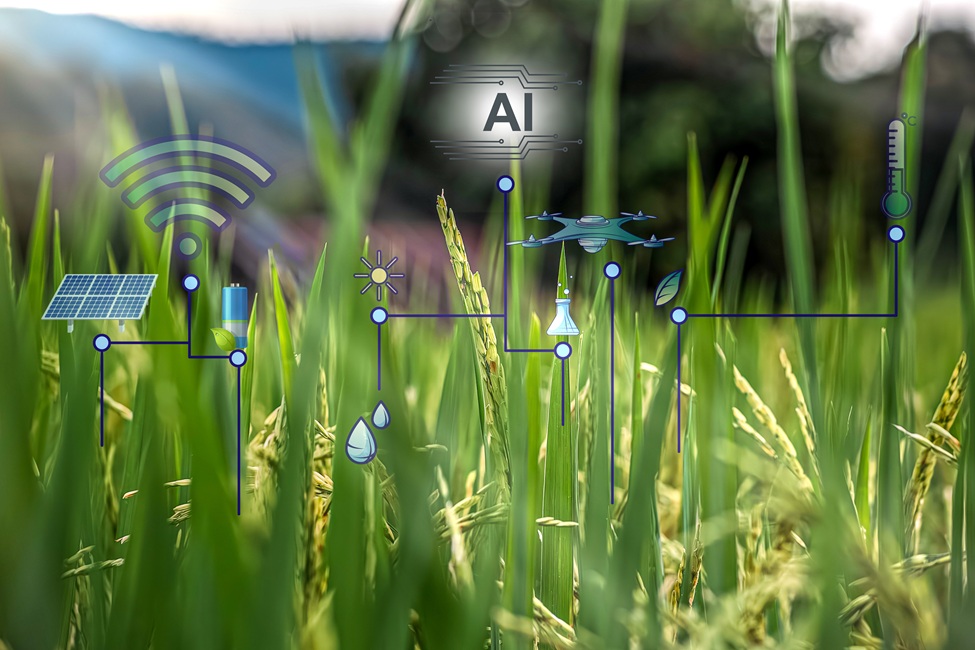FAU Engineering Awarded USDA Grant for Smart Farming Breakthrough

Arslan Munir, Ph.D., an associate professor in the Department of Electrical Engineering and Computer Science within the College of Engineering and Computer Science at Florida Atlantic University, has received an $827,533 grant from the United States Department of Agriculture’s National Institute of Food and Agriculture.
This award will support Munir’s leadership of a groundbreaking, multi-institutional research project with FAU, Kansas State University and Purdue University, aimed at revolutionizing the future of precision agriculture through the development of an advanced edge/fog computing-based framework – called “FogAg” – to enable real-time, multi-layer sensing and analysis of how water and nitrogen levels together affect crop growth and yield.
Agriculture faces mounting pressure to feed a growing population while protecting natural resources. Managing water and nitrogen – two vital yet often limiting crop inputs – is one of the greatest challenges. When mismanaged, they can reduce yields and harm the environment through runoff and waste. Existing smart agriculture tools often fall short in capturing and responding to these complex interactions in real time with the precision farmers need.
Munir’s FogAg framework is designed to fill this technological and scientific gap. By integrating cutting-edge developments in edge/fog computing, cyber-physical systems, and multi-modal sensing, the project offers a scalable solution that can provide actionable insights into plant-soil dynamics. The research will explore new innovations across multiple domains – including architecture, sensing, machine learning and predictive modeling – to deliver a next-generation agricultural system that can interpret and respond to field data in near real-time.
“Receiving this USDA grant is an important milestone in our pursuit of transformative agricultural technologies,” said Munir. “Our goal with FogAg is to create an intelligent, adaptable and energy-efficient framework that empowers farmers with the data they need to make timely, site-specific decisions. By capturing and analyzing the nuanced interactions between water and nitrogen stressors, we aim to not only increase crop yield and quality but also reduce the environmental impact of modern agriculture. This project represents our deep commitment to leveraging advanced computing systems in service of sustainable food production.”
At the heart of FogAg is a novel, three-tiered cyber-physical architecture that spans IoT devices, fog computing nodes and cloud servers, enabling distributed processing and near real-time analytics. Supporting this architecture is Neuro-Sense, a reconfigurable system that facilitates energy-efficient signal and image processing for dynamically changing workloads in the field.
The team will develop and deploy a multi-modal sensing platform that includes an economical and flexible LED-based multispectral imaging system, an innovative near-infrared point measurement sensor, and a novel frequency response-based dielectric soil sensor.
“These tools will enable sensing above, below and within the plant canopy, capturing a comprehensive picture of crop and soil health,” said Munir.
On the data processing front, the project will leverage advanced machine learning techniques, including a highly efficient convolutional neural network accelerator capable of analyzing complex image and sensor data streams. These insights will feed into tree-based predictive models that integrate real-time and historical data to generate site-specific, variable-rate prescriptions for fertilizer and irrigation – maximizing productivity while minimizing input waste.
Beyond its scientific and technical contributions, the FogAg project is poised to make significant societal and environmental impacts. The integration of real-time water and nitrogen management strategies will not only enhance resource-use efficiency and reduce production costs but also help lower agriculture’s nitrogen footprint and associated environmental pollution. With both spatial and temporal scalability, the framework has potential applications ranging from large-scale industrial farms to urban and peri-urban agricultural systems.
“This research epitomizes the kind of forward-thinking, impact-driven innovation at Florida Atlantic University,” said Stella Batalama, Ph.D., dean of the College of Engineering and Computer Science. “Professor Munir’s work is a great example of how engineering can lead transformative change in critical sectors like agriculture. The integration of smart technologies into farming practices not only addresses urgent global challenges around food security and sustainability but also reinforces our role as a leader in cross-disciplinary research with real-world impact.”
In addition to its research agenda, the project will incorporate its findings into both undergraduate and graduate curricula, training the next generation of engineers and scientists in the practical application of smart agriculture technologies. This educational component ensures that the knowledge generated through the FogAg project will have lasting influence, seeding innovation well beyond the duration of the grant.
Munir will be working closely with co-investigators Michell L. Neilsen, Ph.D.; Naiqian Zhang, Ph.D.; Paul Armstrong, Ph.D.; and Rachel L.V. Cott, Ph.D.; representing the departments of computer science, biological and agricultural engineering and agronomy at Kansas State University; as well as Ignacio Ciampitti, Ph.D., Department of Agronomy from Purdue University. This collaboration ensures that the FogAg framework will be designed with both technological sophistication and agronomic practicality.
-FAU-
Latest Research
- 'Frazzled' Fruit Flies Help Unravel How Neural Circuits Stay WiredFAU scientists have discovered that the protein Frazzled (DCC in humans) fine-tunes neuron connections, keeping signals fast and precise - key to a fruit fly's rapid escape reflex and healthy nervous system.
- FAU Innovation Pilot Awards Drive Faculty Research from Lab to MarketThe FAU pilot program offers $500 to $15,000 in seed funding to help researchers turn early discoveries into market-ready technologies, fostering prototypes, industry partnerships and real-world impact.
- Nearly 70 FAU Faculty Named Among World's Top 2% of ScientistsNearly 70 FAU faculty are ranked among the world's top 2% of scientists by Stanford-Elsevier, recognizing their global research impact across 22 fields and 174 subfields from engineering to humanities.
- FAU Researchers Make Great 'Strides' in Gait Analysis TechnologyA first-of-its-kind study explored whether more accessible technologies such as a 3D depth camera could accurately measure how people walk, offering a practical alternative to traditional gait analysis tools.
- FAU Historian Traces How U.S. Nursing Homes Evolved into Big BusinessA historian explores how the Americana Corporation shaped modern nursing homes, revealing how architecture tied aging, care and profit into a system that still defines long-term care in the U.S. today.
- Where a Child Lives - Not Just Diet - Raises Type 2 Diabetes RiskFAU researchers found poor walkability, litter, and reliance on assistance programs are strongly linked to type 2 diabetes risk in young children, based on a large nationwide study.






